Flower
![]()
This article is about the part of plants. For other meanings, see flower (disambiguation).
The flower of a plant is an unbranched short shoot of limited growth observed after the onset of flower maturity, the leaves of which are indirectly or directly in the service of sexual reproduction: indirectly as protective or attracting organs (perianth), directly by forming the reproductive organs (stamens and carpels).
Often only the flower of the angiosperms is understood by flower, because they are the flowering plants in the narrower sense. Nevertheless, the gymnosperms also have flowers or inflorescences.
An angiosperm flower consists of the following components (which, however, do not all have to be represented): the flower axis (flower base), from which the flower organs arise: a perianth as perigone or separated into a calyx and corolla, the androeceum of stamens and the gynoeceum of carpels. The stamens form the pollen, which during pollination reaches the stigma of the carpels, germinates there and fertilizes the ovules located in the carpel, more precisely the ovule located in the ovule (fertilization). The fertilized ovum develops into the plant embryo, the ovule develops into the seed and all the remaining parts of the flower become the fruit.
Flowers containing only carpels are colloquially referred to as "female", those containing only stamens as "male", and flowers which have both stamens and carpels as bisexual or hermaphrodite flowers (See below: Sex).

Schematic representation of the internal structure of the floral organs of an angiosperm flower
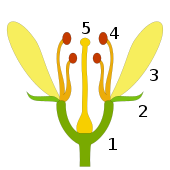
Schematic representation of the parts of an angiosperm flower with perigynous perianth (= "medium" ovary): 1. receptacle 2. sepals 3. corolla petals 4. Petals4. Stamens (stamina) 5. pistil (pistil)

Selection of differently constructed flowers at different stages of development of vascular plants. Below left a "flower" of a horsetail.
Definitions
The broad definition of blossom (from Middle High German/ Old High German bluot with the plural blüete), as often found in botanical literature, sometimes explicitly or implicitly includes the flowers of the gymnosperms. Only rarely, by naming the parts in the definition, is it implicitly restricted to the angiosperms. In the Strasburger - Lehrbuch der Botanik, in reference to all seed plants, their flowers are spoken of, though with qualifications: 'The sporophylls are almost always on short shoots with limited growth in the Spermatophytina. Such [...] structures may be called flowers, although this term is usually used only for the primarily hermaphroditic sporophylls of the angiosperms and possibly closely related fossil seed plants." The Dictionary of Biology also briefly defines a flower as "a short shoot of limited growth bearing the sporophylls."
· 
Example of a female and a male inflorescence of a palm fern
· 
Example of a female inflorescence of a gymnosperm (here pine)
· 
Female inflorescence of a Scots pine enlarged
·
Example of a male inflorescence of a gymnosperm (here Scots pine)
· 
Example of a flower of the eudicotyledons with sepals, petals, pistil and stamens (here meadow cranesbill)
· 
Example of a flower of the monocotyledons with perigone, pistil and stamens (here fire lily)
· .jpg)
Example of an inflorescence in the sweet grasses
Fossil representatives outside the seed plants that formed flowers are the Bennettitales and Caytoniales. The definition of a flower is also met by the sporophylls of lycopods and horsetails, but these are not discussed in detail here.
In English-speaking countries, flower (botanically: flower) is usually defined more narrowly as an angiosperm flower, e.g..: "shortened, hermaphroditically reproductive shoot axis with limited growth, consisting of megasporangia (carpels) and microsporangia (stamens) and a sterile perianth of at least one sterile, flat organ."
Morphology
In angiosperms, the individual flower organs are arranged within the flower in a fixed order from the bottom to the top, or, since the flower axis is compressed, from the outside to the inside. In this order they are also ontogenetically laid out (in the course of flower formation).
Flower axis
→ Main article: Flower axis
The petals are attached to the flower axis (flower base or receptacle). It can be compressed, stretched and differently shaped. Single or several whorls can be raised by intercalary meristems: For example, in capers the gynoecium is raised (gynophore), in passion flowers the gynoecium and androeceum are raised (androgynophore), and in many carnations the corolla, androeceum the gynoecium are raised (anthophore).
Ring-shaped areas around the center can also be raised. An example is a stamen corolla tube, typical of many composite plants, or the calyx-cup of many cucurbits. A broadened flower axis is called a flower cup (hypanthium).
If all parts except the ovary are lifted up, a flower tube is formed, which carries the perianth and the stamens. A perigynous flower cup is formed. The ovary is then called median. A superior ovary stands freely on the flower axis. If the outer sides of the carpels are included in a perianth, an inferior ovary is formed, which means that it is below the perianth, as in the case of roses, for example.
Bloom cover
→ Main article: Tepal, corolla and sepal
The perianth are sterile leaves, but they clearly belong to the flower. A perianth is only formed by Gnetopsida and angiosperms. If all petals are uniformly formed (homoiochlamydean), the perianth is called perigone or simple perianth, the leaves are called tepals (e.g. in the tulip). Here the perigone may consist of one circle (haplo- or monochlamydean), two or more circles, or several helical orbits; multiple perigone. A double perianth (di-, heterochlamydean flowers) consists of unequal petals. The outer, usually green, leaves are the sepals and form the calyx; the inner, often strikingly colored, leaves are the petals and form the corolla. The evolutionary origin of the perianth is interpreted from bracts or from stamens, depending on the relationship group.
Microsporophylls
→ Main article: Stamen
Microsporophylls are sporangia-bearing leaves. The male microspores are formed in the sporangia (pollen sacs). The microsporophylls are very differently formed depending on the seed plant group, and a homology to leaves (φύλλον phýllon "leaf") has not been fully clarified. More neutrally, therefore, they might be called microsporangia carriers. In the ginkgo, the microsporophyll is a stalk with two pollen sacs hanging from its tip; the microsporophylls stand to many helically on the flower axis. In the conifers, the male flower is cone-like and consists of many microsporophylls, usually arranged in a helical fashion; there are from two to 20 pollen sacs on each microsporophyll. In the palm ferns (Cycadeae), the microsporophylls are scale-like and bear five to 1000 pollen sacs; the microsporophylls stand in a helical arrangement in the male flower. In Welwitschie, the six intergrown microsporophylls each bear three pollen sacs. In Gnetum, the single microsporophyll bears one or two terminal pollen sacs. In Ephedra, the microsporophyll is often forked and bears two to eight groups of usually two fused pollen sacs.
The microsporophylls of angiosperms are called stamens (stamina). A stamen is usually divided into the filament and the anther. The latter consists of two thecae connected by the connective to two pollen sacs each. The entirety of the stamens is called androeceum. The number of stamens per flower is between one and about 2000.
Megasporophylle
→ Main article: Gynoeceum
The megasporophylls carry the ovules characteristic of seed plants, inside which are the actual female reproductive organs containing the plant ovules. The megasporophylls could also be more neutrally called megasporangia carriers. Only in the angiosperms are the megasporophylls called carpels.
In the palm ferns the ovules are clearly on leaves, they are phyllosporous. The scale- or shield-shaped megasporophyll is clearly stalked and bears two ovules at the lower edge of the blade, in Cycas there are up to eight ovules along the rhachis. In the conifers, there are one to 20 ovules on the surface of a planar seed scale. The seed scale is a modified short shoot. Rarely are the ovules in conifers terminal on short shoots, as in yew (Taxus). Ginkgo forms two ovules at the tip of a forked stem. The Gnetopsida form only one terminal ovule per flower.
In angiosperms the ovules are enclosed in the carpel, hence the name "angiosperm". The entirety of the carpels forms the gynoecium. The number of carpels per flower ranges from one to about 2000. Usually an ovary is divided into a pedicel zone and a tubular zone, the hollow area where the ovules are located (also called ovary). The ovules attach to placentas. Above this often attaches a style, on which is the stigma, the receptive area for the pollen. The stigma is connected to the ovules by a transmission duct or tissue. The carpels may be free (apocarpic or choricarpic gynoecium) or fused together (coenocarpic). If the gynoecium is fused, it is called a pistil. Sterile flowers have at most reduced stamens and carpels and often have the function of a display apparatus.
Nectaries
→ Main article: Nectary
Nectaries are glands that produce nectar to attract flower pollinators. This usually consists of a sugar solution, which may also contain proteins, amino acids and vitamins. Less frequently, oils are formed (for example, in loosestrife, Lysimachia). Nectaries can be formed by the perianth, the stamens, the ovary, the flower axis, but also outside the actual flower (extrafloral).
Position and arrangement
The petals may be arranged helically (acyclic) or whorled (cyclic) on the flower axis, depending on the leaf position (phyllotaxy). A helical arrangement is often considered a primitive feature and it is often associated with a higher number of petals. The angle between two successive petals is usually close to that of the golden section of about 137.5°.
Often only a part of the petals is helical, while the inner petals are whorled. These flowers are called spirocyclic or hemicyclic. A transition from helical to whorled occurs when, as in the Yulan magnolia (Magnolia denudata), there is a pause in leaf formation after every three petals, resulting in whorls of three petals in approximation. In many whorled flowers, too, a helical sequence of leaf formation can be seen in development, but the leaves of a circle are so close together that a whorl is formed.
In whorled position, each whorl or circle contains only one type of petal. The whorl position is also accompanied by a reduction in the number of petals (oligomeric circles). Most whorled hermaphrodite flowers have four (tetracyclic flower) or five (pentacyclic) whorls: one sepal, one corolla, one or two stamens, and one carpel. In most angiosperms, the number of leaves per whorl is also fixed; accordingly, one speaks of two-, three-, four- or five-petaled flowers. If all whorls have the same number of members, the flower is isomeric (for example in the tulip), if this is not the case, the flower is heteromeric.
The leaves of superimposed whorls are usually on gap (alternance principle), that is, the members of the next inner whorl are in the gap between two members of the previous whorl. In pentacyclic flowers, it often happens that the inner stamen circle is pushed outward by the ovary, apparently becoming the outer one. This phenomenon is called obdiplostemonia. All petals may be more or less fused with their own kind or with others.
If more than three planes of symmetry can be placed through a flower, it is radially symmetric (like the tulip). If there are two planes of symmetry, it is disymmetric, as in Dicentra. One plane of symmetry has zygomorphic (dorsiventral) flowers. Usually this plane of symmetry lies in the median plane of the flower (i.e. runs through the bract and the shoot axis of the bract), as in the labiates, more rarely perpendicular to the median plane, as in the larkspur. Asymmetrical flowers do not have a plane of symmetry. Strictly speaking, screw-shaped flowers also belong to this category, but they are usually considered to be radially symmetrical.
The relationships of the flower parts to each other can be represented graphically in flower diagrams or in flower formulas.
Often several or many single flowers are united to inflorescences.
Gender
The original form for the angiosperms are hermaphrodite flowers. In addition, there are unisexual flowers ("separately sexed"), the organs of the other sex are usually also present as rudiments: There are staminate ("male") and pistillate ("female") flowers. Plants and clades with unisexual flowers may be monoecious (monoecious, male and female flowers on one plant) or dioecious (dioecious, male and female flowers on different plants). Polygamous plants have both hermaphrodite and unisexual flowers.
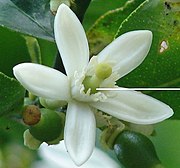
Lime
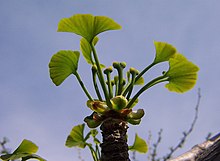
Megasporophyll on Ginkgo biloba

Megasporophyll with mature seeds of the cycad Dioon edule
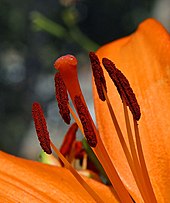
Many monocotyledons have six stamens (here Hemerocallis)
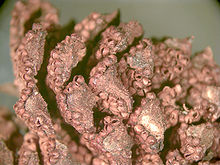
Microsporophylls with many sporangia in the cycad Ceratozamia
Questions and Answers
Q: What is a flower?
A: A flower is the reproductive part of flowering plants.
Q: What are other names for flowers?
A: Flowers are also called the bloom or blossom of a plant.
Q: What parts do flowers have?
A: Flowers have petals and inside the part of the flower that has petals are the parts which produce pollen and seeds.
Q: Why do we say a plant 'flowers'?
A: We say a plant 'flowers', 'is flowering' or 'is in flower' when its colourful part begins to grow bigger and open out.
Q: Are there different kinds of flowers around the world?
A: Yes, there are many different kinds of flowers in different areas in the world. Even in cold places like the Arctic, flowers can grow during certain months.
Q: How do flowers grow on plants?
A: Flowers may grow separately on the plant, or they may grow together in an inflorescence.
Search within the encyclopedia
